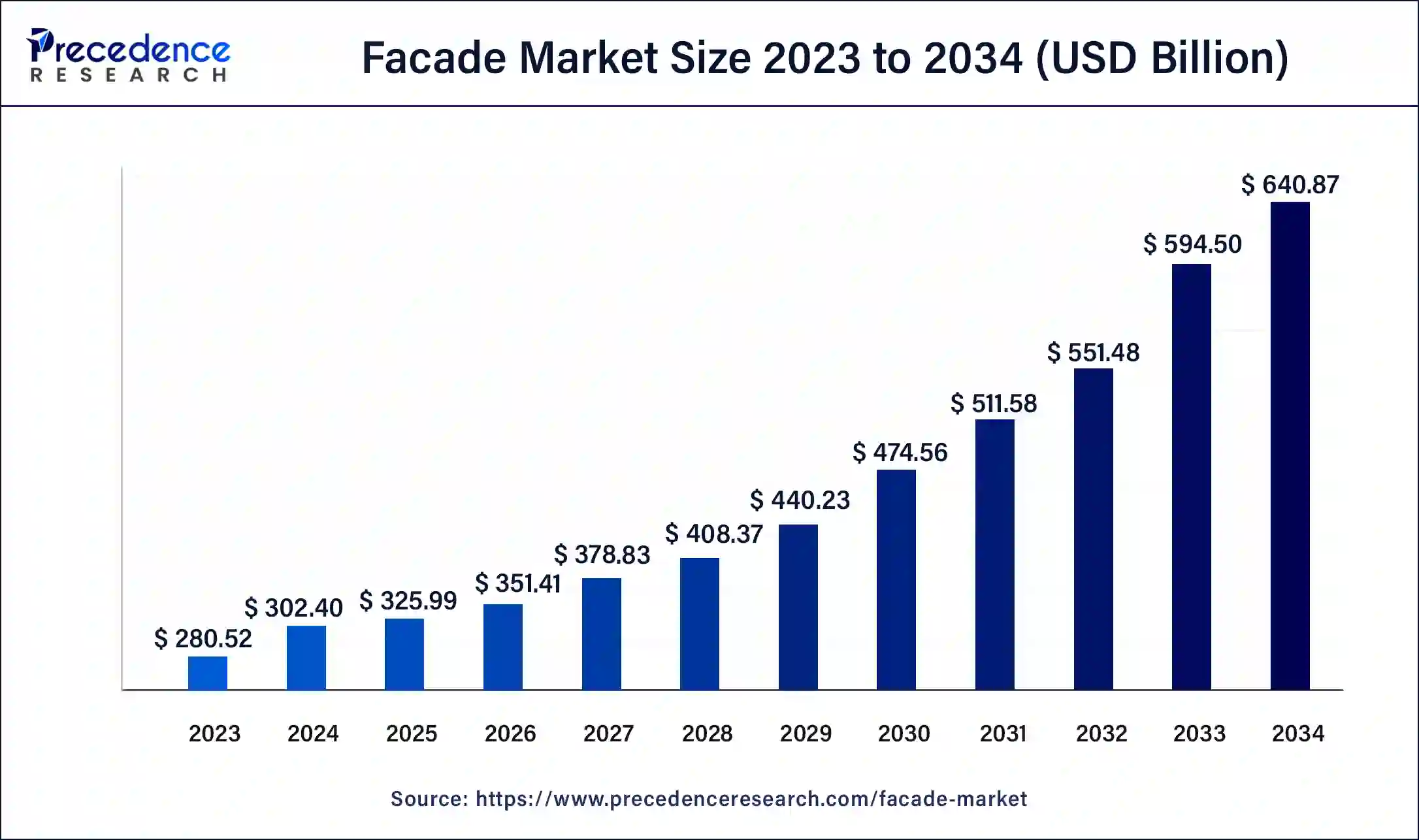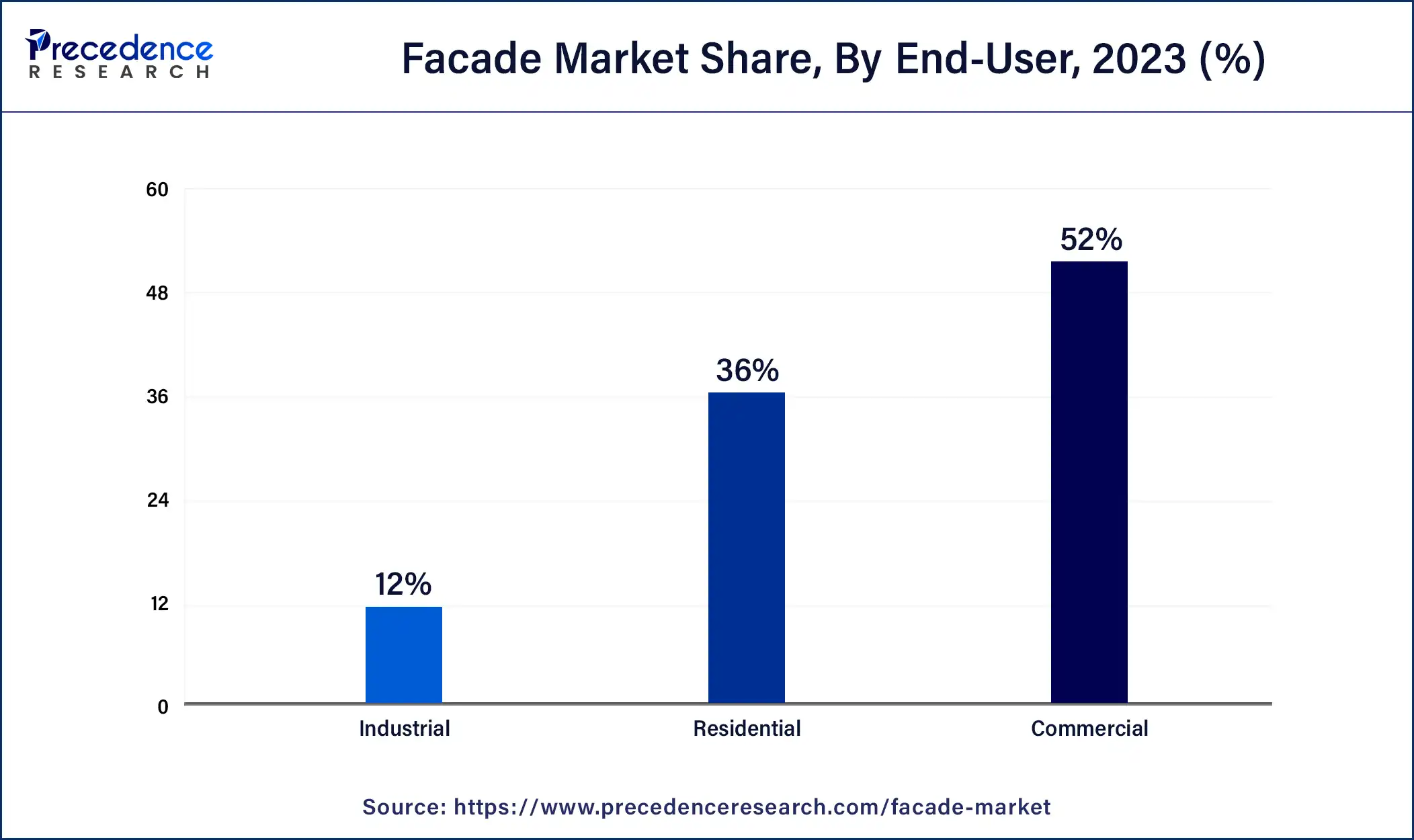Facade Market (By Product Insights: Ventilated Facades, Non-ventilated Facades; By End-use Insights: Commercial, Residential, Industrial) - Global Industry Analysis, Size, Share, Growth, Trends, Regional Outlook, and Forecast 2024-2034
The global facade market size accounted for USD 302.40 billion in 2024 and is expected to reach around USD 640.87 billion by 2034, expanding at a CAGR of 7.8% from 2024 to 2034.

The Asia Pacific facade market size was estimated at USD 106.60 billion in 2023 and is predicted to be worth around USD 243.53 billion by 2034, at a CAGR of 6.7% from 2024 to 2034.

Asia Pacific is expected to sustain its position in the market during the forecast period. The growth of the region is attributed to the rising industrial, commercial and residential construction activities in the region. The rising population is one of the major factors for the developing commercial and residential sectors. Facades are sustainable, innovative designs in the facades, and safety is the major concern that is responsible for the growth of the facades market across the region.
China is observed to be the largest contributor for the market’s growth for the upcoming period. The advancements in façade installation techniques, availability of labors, cost-effective material and rising investments in the construction industry are a few factors to fuel the country’s growth.
North America is expected to account for a notable share of the market during the forecast period. The growth of the market in the region is expected to be boosted due to the rising construction industry across the region. Increasing demand for solar facades from the countries like the United States and Canada will contribute to the growth of the market during the forecast period. Rising government initiatives for the development of the construction sector is expected to propel the growth of the façade market in North America.
The Middle East is expected to grow at a considerable pace during the anticipated period. Rising government support for the development of real-estate industry and developing economies in the region is fueling the growth of the market across the region. The gulf countries, such as Dubai, Qatar, Kuwait showing and tremendous growth in the real-estate industry and in the fancy world class buildings, these would result in the higher demand for the façades. These factors will contribute to the growth of the market in the Middle East.

The facade market usually deals with building facades while it covers the development and distribution of materials, designs and technologies associated with building facades. The façade market revolves around multiple elements including metal, glass, cladding systems and insulation. Facades are generally referred to as one part of the building, mostly the front side of the building’s architecture.
In recent times it has become one of the most important parts of the building which offers an aesthetic look and unique character to the building construction. Facades can be installed in the new building or in the building which is under the renovation process. Rising construction activities across the globe are likely to contribute to the growth of the facades market. The increase in the market is attributed to the rising demand from the commercial and industrial sectors.
Multiple commercial buildings including offices and malls try to maintain the aesthetics of buildings, facade plays a big role in the outer structure of the building through their detrimental effects. Such rising demand will act as a growth factor for the market. Facades are also beneficial for energy efficiency, apart from the aesthetic functionality facades play an important role in the consumption of energy by reducing energy bills, facades minimize the absorption of heat hence it reduces the cooling loads of the buildings which results in lower energy bills. One of the major valuable characteristics of the facades is the resistance to temperature and humidity.
In addition, solar facades are considered one of the most emerging types of facades. These advanced types of solar facades absorb solar energy and are used in several residential and commercial buildings as a secondary source of energy. The rising demand from regions like Asia Pacific, North America, and the Middle East is enhancing the growth of the facades market.
| Report Coverage | Details |
| Growth Rate from 2024 to 2034 | CAGR of 7.8% |
| Market Size in 2023 | USD 280.52 Billion |
| Market Size in 2024 | USD 302.40 Billion |
| Market Size by 2034 | USD 640.87 Billion |
| Largest Market | Asia Pacific |
| Base Year | 2023 |
| Forecast Period | 2024 to 2034 |
| Segments Covered | By Product and By End-use |
| Regions Covered | North America, Europe, Asia-Pacific, Latin America, and Middle East & Africa |
Higher energy performance
Energy efficiency is crucial when it comes to building construction, and environmental effect is a crucial aspect of any project. The best use of natural light and ventilation can be made possible by a well-structured facade. Glass facades allow for more natural light to enter buildings, reducing the need for artificial lighting. Such facades can now regulate and cool a building's interior thanks to new breakthroughs in glass materials. Overall, while offering high energy performances, the facades reduce the overall cost invested in cooling the infrastructure. Thus, the element is observed to fuel the market’s growth.
Lack of flexibility
The lack of flexibility in the facades market can restrain innovation and adaptability. It may lead to limited design options, making it harder to meet diverse aesthetic and functional requirements. Without flexibility, the industry might struggle to respond to changing environmental regulations and energy efficiency demands, hindering its overall growth and competitiveness of the market.
Development of kinetic facades
Kinetic facades are dynamic facades that change rather than static, as the name suggests. Its elements can be programmed to react to environmental elements, to increase energy efficiency, decrease solar heat, or for aesthetic purposes, such as an art piece. In addition to this, these kinetic facades offer some rain protection, they do not significantly improve thermal performance. By adjusting their position, kinetic facades can control the amount of natural light and heat entering the building, thus contributing to energy savings and reducing the need for artificial lighting and cooling. Thus, the rising requirement and development for kinetic facades present opportunities for the market to grow.
The ventilated facades dominated the market with the largest market share in 2023, the segment will continue to grow at a significant rate during the forecast period. The growth of the segment is attributed to higher adoption of ventilated facades by the cold regions across the world. Ventilated facades are dry-installed exterior surface for building. The main objective of the ventilated facades is to maintain the exchange of air, light, and heat that goes between the interior and exterior of the building. It can be installed in the new building infrastructure or the building which is under renovation process. The ventilated facades are mainly made up of glass material that can transfer heat to provide a low temperature. There is rising demand from cold-weathered countries like countries in the European region for ventilated facades. Therefore, the segment is projected to witness significant growth during the forecast period.
On the other hand, the non-ventilated facades segment is expected to grow steadily during the forecast period. Non-ventilation facades are constructed with no ventilation or air cavity. such facades are made of a single-layer, non-ventilated structure. This structure is mostly constructed on slopped roofs for residential purposes. They offer a slim design due to its no ventilation structure, the installations of non-ventilated facades also reduce the time of installation during the building construction.
The commercial segment dominated the market with the largest market growth in 2023, the segment is expected to generate a considerable and significant revenue during the forecast period. The growth of the segment is attributed to the rising use of facades for the protection of the interior and for giving a visually appealing look to the outer surface. The rising commercial and industrial construction across the world, especially in the developing countries, significantly promotes the segment’s growth. Facades for commercial sector often have demand from retail shops, hotels, warehouses, malls and office buildings, to maintain the outer appearance of the building.

The residential segment is expected to witness a significant shift in its market share during the predicted time period. Facades installed for houses generally require low maintenance. The demand for facades from residential sector is observed to grow with the rising retrofitting activities for homes and residential buildings.
Segments Covered in the Report:
By Product
By End-use
By Geography
For inquiries regarding discounts, bulk purchases, or customization requests, please contact us at sales@precedenceresearch.com
No cookie-cutter, only authentic analysis – take the 1st step to become a Precedence Research client